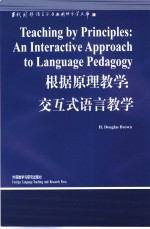
- 作 者:(美)H.Douglas Brown著;文秋芳导读
- 出 版 社:北京:外语教学与研究出版社
- 出版年份:2001
- ISBN:7560024610
- 标注页数:476 页
- PDF页数:516 页
请阅读订购服务说明与试读!
订购服务说明
1、本站所有的书默认都是PDF格式,该格式图书只能阅读和打印,不能再次编辑。
2、除分上下册或者多册的情况下,一般PDF页数一定要大于标注页数才建议下单购买。【本资源516 ≥476页】
图书下载及付费说明
1、所有的电子图书为PDF格式,支持电脑、手机、平板等各类电子设备阅读;可以任意拷贝文件到不同的阅读设备里进行阅读。
2、电子图书在提交订单后一般半小时内处理完成,最晚48小时内处理完成。(非工作日购买会延迟)
3、所有的电子图书都是原书直接扫描方式制作而成。
PARTI Foundations for Classroom Practice 3
Chapter1 Where Do I Begin? 3
A Classrom Observation, 4
Beneath the Lesson, 10
Preface by Halliday 12
王宗炎序 13
Topics for Discussion,Action,and Research, 13
For Your Further Reading, 14
Chapter2 Teaching by Principles 15
Preface by Chomsky 16
Cognitive Principles, 16
Affective Principles, 22
沈家煊序 23
Linguistic Principles, 26
导读 26
Topics for Discussion,Action,and Research, 31
For Your Further Reading, 32
Chapter3 Intrinsic Motivation in the Classroom 33
Defining Motivation, 34
Dead Poets Society, 37
PREFACE 37
Intrinsic and Extrinsic Motivation, 38
Intrinsic Motivation in Education, 39
ACKNOWLEDGMENTS 40
Intrinsic Motivation in the Second Language Classroom, 42
Topics for Discussion,Action,and Research, 45
For Your Further Reading, 46
Chapter4 A“Methodical”History of Language Teaching 47
Approach,Method,Technique, 48
Changing Winds and Shifting Sands, 51
The Grammar Translation Method, 52
Gouin and the Series Method, 54
The Direct Method, 55
The Audiolingual Method, 56
“Designer”Methods of the Spirited Seventies, 58
Beyond Method:Notional-Functional Syllabuses, 66
Topics for Discussion,Action,and Research, 69
For Your Further Reading, 72
Chapter5 The Present:An Informed“Approach” 73
An Approach for Enlightened Eclectics, 74
Communicative Language Teaching, 77
Untangling Some Current Jargon, 80
Topics for Discussion,Action,and Research, 84
For Your Further Reading, 85
PART II Contexts of Teaching 89
Chapter6 Learner VariablesI:Teaching Across Age Levels 89
Teaching Children, 90
Teaching Adults, 94
Teaching in Between, 95
Topics for Discussion,Action,and Research 97
For Your Further Reading, 98
Chapter7 Learner VariablesII:Teaching Across Proficiency Levels 99
Defining Proficiency Levels, 100
Teaching Beginning Levels, 101
Teaching Intermediate Levels, 111
Teaching Advanced Levels, 114
Topics for Discussion,Action,and Research, 117
For Your Further Reading, 118
Sociopolitical Contexts, 119
Chapter8 Sociopolitical and Institutional Contexts 119
Second and Foreign Language Contexts, 120
English as an International Language, 122
Language Policy Issues, 123
Institutional Contexts, 125
Topics for Discussion,Action,and Research, 130
For Your Further Reading, 131
PART III Designing and Implementing Classroom Techniques 135
Chapter9 Techniques and Materials 135
Techniques Redefined, 136
Categorizing Techniques:A Bit of Histiory, 137
A Taxonomy of Techniques, 141
Supporting Materials, 144
Topics for Discussion,Action,and Research, 154
For Your Further Reading, 155
Chapter10 Interactive Language TeachingI:Initiating Interaction 157
What Is Interaction? 159
Interactive Principles, 159
Roles of the Interactive Teacher, 160
Foreign Language Interaction Analysis, 162
Questioning Strategies for Interactive Learning, 164
Topics for Discussion,Action,and Research, 168
For Your Further Reading, 169
Chapter11 Interactive Language TeachingII:Sustaining Interaction Through Group Work 171
Advantages of Group Work, 173
Excuses for Avoiding Group Work, 175
Implementing Group Work in Your Classroom, 178
Topics for Discussion,Action,and Research, 187
For Your Further Reading, 188
Chapter12 Learner Strategy Training 189
Strategic Investment, 190
Good and Bad Language Learners, 191
Styles of Successful Language Learning, 192
Developing Student Self-awareness of Style Tendencies, 193
How to Teach Strategies in the Classroom, 200
Packaged Models of Learner Strategy Training, 209
Topics for Discussion,Action,and Research, 213
For Your Further Reading, 214
Chapter13 Integrating the Four Skills 217
Why Integration? 218
Content-based Teaching, 220
Theme-based Teaching, 221
Experiential Learning, 224
The Episode Hypothesis, 225
Task-based Teaching, 227
Topics for Discussion,Action,and Research, 231
For Your Further Reading, 232
Chapter14 Teaching Listening Comprehension 233
Listening Comprehension in Pedagogical Research, 234
An Interactive Model of Listening comprehension, 235
Types of Spoken Language, 236
What Makes Listening Difficult? 238
Microskills of Listening Comprehension, 241
Types of Classroom Listening Performance, 242
Principles for Designing Listening Techniques, 244
Listening Techniques from Beginning to Advanced, 247
Topics for Discussion,Action,and Research, 251
For Your Further Reading, 252
Chapter15 Teaching Oral Communication Skills 253
Oral Communication Skills in Pedagogical Research, 254
Types of Spoken Language, 256
What Makes Speaking Difficult? 256
Microskills of Oral Communication, 257
Teaching Pronunciation:Then and Now, 258
Factors Affecting Pronunciation Learning, 259
A Model for Correction of Speech Errors, 262
Types of Classroom Speaking Performance, 266
Principles for Designing Speaking Techniques, 268
Techniques for Teaching Oral Communication Skills, 270
Topics for Discussion,Action,and Research, 279
For Your Further Reading, 281
Chapter16 Teaching Reading 283
Research on Reading a Second Language, 283
Types of Written Language, 286
Characteristics of Written Language, 287
Microskills for Reading Comprehension, 290
Strategies for Reading Comprehension, 291
Types of Classroom Reading Performance, 297
Principles for Designing Interactive Reading Techniques, 298
Two Reading Lessons, 301
Topics for Discussion,Action,and Research, 316
For Your Further Reading, 317
Chapter17 Teaching Writing Skills 319
Research on Second Language Writing, 320
Types of Written Language, 325
Characteristics of Written Language:A Writer s View, 325
Types of Classroom Writing Performance, 327
Microskills for Writing, 327
Principles for Designing Writing Techniques, 330
Topics for Discussion,Action,and Research, 344
For Your Further Reading, 345
Chapter18 The Place of Grammar and Vocabulary 347
The Place of Grammar, 347
To Teach or Not to Teach Grammar, 349
Issues About How to Teach Grammar, 351
Grammar Techniques, 354
Grammar Sequencing in Textbooks and Curricula, 364
A Word About Vocabulary Teaching, 365
Topics for Discussion,Action,and Research, 370
For Your Further Reading, 371
Chapter19 Creating Interactive,Intrinsically Motivating Tests 373
Testing and Teaching, 375
Signs of Hope in Language Testing, 376
Intrinsically Motivating Language Tests, 382
Some Practical Steps to Test Construction, 386
Tests Can Aid Learning! 390
Topics for Discussion,Action,and Research, 391
For Your Further Reading, 392
PART IV Classroom Practicalities 395
Chapter20 How to Plan a Lesson 395
Format of a Lesson Plan, 396
Guidelines for Lesson Planning, 398
Sample Lesson Plan, 403
Topics for Discussion,Action,and Research, 409
For Your Further Reading, 410
Chapter21 Classroom Management 411
The Classroom Itself, 412
Your Voice and Body Language, 413
Unplanned Teaching:Midstream Lesson Changes, 414
Teaching Under Adverse Circumstances, 415
Teachers Roles and Styles, 419
Creating a Positive Classroom Climate, 421
Topics for Discussion,Action,and Research, 422
For Your Further Reading, 424
Chapter22 Lifelong Learning:continuing Your Teacher Education 425
Peak Performers, 426
The Good Language Teacher, 428
Classroom Observation, 431
Classroom Research, 437
Agents for Change, 441
Topics for Discussion,Action,and Research, 442
For Your Further Reading, 443
BIBLIOGRAPHY 445
INDEX 461
文库索引 468
